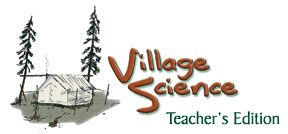|
Teacher
Edition Contents
Skill,
Tools, & Craftsmanship
Cutting
& Drying Fish
Sharpening
Nails,
Pegs, & Lashings
Falling
Trees &
Small-Scale
Logging
Guns
Chainsaw
Clutch & Chain
Ice
Pick
Shelters
Wood
Stoves
Wall
Tents
Steambaths
Insulation
& Vapor Barriers
Gas
Lamps & Gas Stoves
Travel
Piloting
A Boat
Boat
Design
Magnetos
& Spark Plugs
Carburetors
Compression
Outboard
Motor Lower Unit
Outboard
Motor Cooling System
Dogsleds
Snowmachine
Tracks
Snowmachine
Clutch
Snowshoes
Winter
Trails
|
Activities
- Ask the oldtimers in your village what they use for tent floor.
If they use spruce bark, get someone to show you how to peel one,
although this only works from late May to mid July.
- Pitch a wall tent. Make the roof nice and tight. How big is
it? 10’ x 12’, 8’ x 10’? How high are the
walls? When you put the tent away, ask an experienced person to
teach you the right way to fold it.
- Touch the inside of the tent when it is raining. Does it leak
down your finger?
It probably will. Rain water runs through a tent not over
it.
- Make a bed for the tent. Is it warmer on the bed than on the
floor?
It should be much warmer on the bed.
- Make a stove for a tent. Make a half-a-drum stove or a five-gallon
can stove. We used to use Blazo cans, but square cans are now
available from hotels and restaurants where they buy coffee in
square five gallon cans. Take your time and make a stove to be
proud of.
- Ask the experienced people in your village about tent stoves
and sparks. How do they keep from burning their tent down?
- What kinds of tents are used in your village now? Many people
still use wall tents for hunting camps. How many of the tents
are wall tents? How many of them are white? How many of another
color? Of the canvas wall tents, do any have evidence of mildew?
Why or why not?
- Ask in the village why some people use nylon dome tents?
They are light and easy to set up.
Student Response
- What are four kinds of flooring for a tent? Which is best in
the winter on the snow?
Spruce bark, boards, gravel, spruce boughs. Spruce boughs
are best in winter.
- What wood burns with the most sparks? With the least?
Tamarack. Cottonwood or willows
- What are two techniques to reduce sparks on a tent?
Make holes in the top pipe to cool the sparks or put a screen
over the top of the pipe
- Why is a white tent warmer than a dark one?
It reflects the radiant heat of the stove much better
- Does water run off or through canvas tent fabric?
Through
- What are two advantages of having a bed?
Warm air rises, so it is warmer on the bed than on the ground.
It also allows room under the bed for storage
Math
- What is the difference in floor space between a 10’ x 12’
tent and an 8’ x 10’?
40 sq. ft.
- Frank’s tent weighs 72 lbs. His stove and pipes weigh
another 27 lbs. He can haul 200 lbs in his sled to his trapline.
How many pounds of groceries and gas can he haul on the same trip?
101 lbs
- Ed spent $225 for a 10’ x 12’ wall tent with 4’
walls. He used it for two seasons, but put it away wet and it
rotted. The tent could have lasted eight years if well cared for.
How much did the tent cost him per year? How much should it have
cost him per year? Can you put a price tag on his laziness?
$112.50 per year. If it lasted eight years it would have cost
$28.13 per year. His laziness cost $168.75
|
